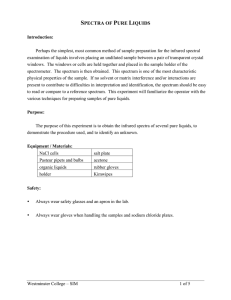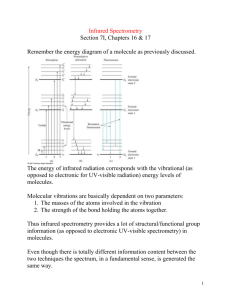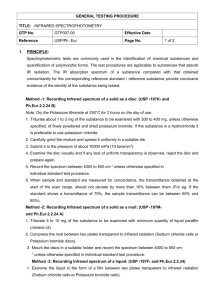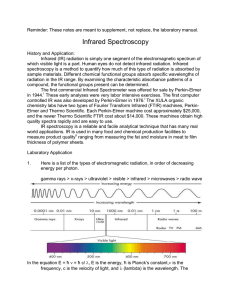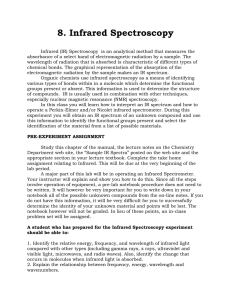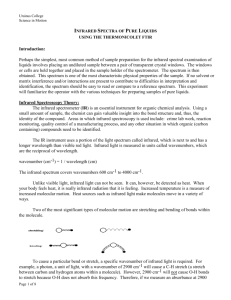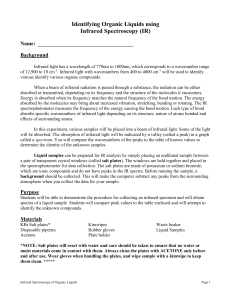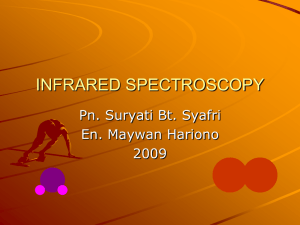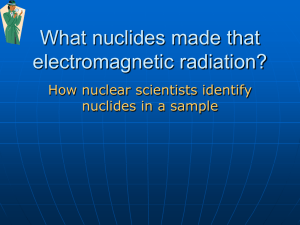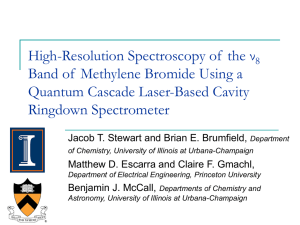SPECTRA OF PURE LIQUIDS
advertisement
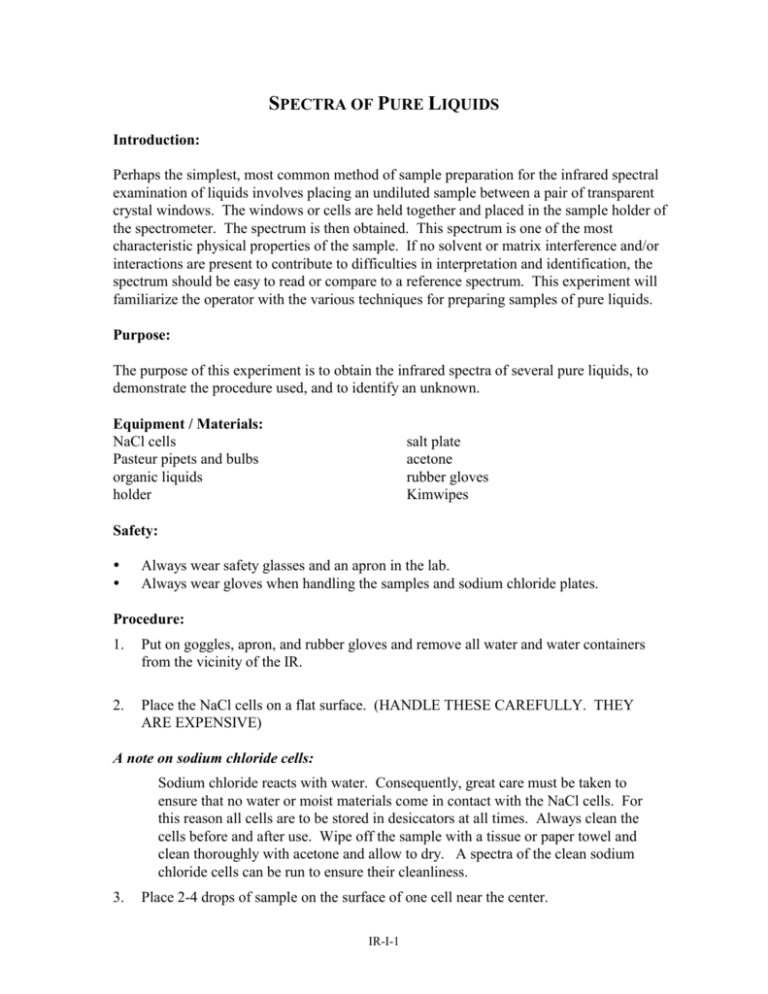
SPECTRA OF PURE LIQUIDS Introduction: Perhaps the simplest, most common method of sample preparation for the infrared spectral examination of liquids involves placing an undiluted sample between a pair of transparent crystal windows. The windows or cells are held together and placed in the sample holder of the spectrometer. The spectrum is then obtained. This spectrum is one of the most characteristic physical properties of the sample. If no solvent or matrix interference and/or interactions are present to contribute to difficulties in interpretation and identification, the spectrum should be easy to read or compare to a reference spectrum. This experiment will familiarize the operator with the various techniques for preparing samples of pure liquids. Purpose: The purpose of this experiment is to obtain the infrared spectra of several pure liquids, to demonstrate the procedure used, and to identify an unknown. Equipment / Materials: NaCl cells Pasteur pipets and bulbs organic liquids holder salt plate acetone rubber gloves Kimwipes Safety: Always wear safety glasses and an apron in the lab. Always wear gloves when handling the samples and sodium chloride plates. Procedure: 1. Put on goggles, apron, and rubber gloves and remove all water and water containers from the vicinity of the IR. 2. Place the NaCl cells on a flat surface. (HANDLE THESE CAREFULLY. THEY ARE EXPENSIVE) A note on sodium chloride cells: Sodium chloride reacts with water. Consequently, great care must be taken to ensure that no water or moist materials come in contact with the NaCl cells. For this reason all cells are to be stored in desiccators at all times. Always clean the cells before and after use. Wipe off the sample with a tissue or paper towel and clean thoroughly with acetone and allow to dry. A spectra of the clean sodium chloride cells can be run to ensure their cleanliness. 3. Place 2-4 drops of sample on the surface of one cell near the center. IR-I-1 4. Quickly place the second cell on top of the first one. (If necessary use the top cell to spread the sample on the bottom plate so there are no air spaces or bubbles.) 5. Place the NaCl cells in the salt plate holder, and place in the infrared spectrometer. 6. Run a scan of the sample. If the spectrum stays very close to the top of the chart and shows little change throughout, probably too little sample was used. Apply more sample and obtain another spectrum. If the spectrum goes to the bottom of the chart and the peaks are very wide and flat on the bottom, you probably used too much sample. Separate the plates, wipe one of the plates off, put them back together, and run another spectrum. 7. Clean the salt plates with acetone, dry, and place in a desiccator. 8. Identify the sample from the spectrum, the chart of absorbance bands, and the list of possibilities given by the instructor. Data Table: List and identify the major peaks. Sample:_____________________ Major Peaks (cm-1) _______________ _______________ _______________ _______________ _______________ Functional groups ________________ ________________ ________________ ________________ ________________ Sample:_____________________ Unknown # __________________ Major Peaks (cm-1) _______________ _______________ _______________ _______________ _______________ Functional groups ________________ ________________ ________________ ________________ ________________ Identity of Unknown: __________________ Attach Spectrum IR-I-2 Questions: 1. What is the identity of your sample? How did you find this (include the reference)? 2. Why must water be kept away from this experiment? 3. Since we use salt plates for this experiment, what can you conclude about the interaction of salt with infrared radiation? 4. How do the frequency and wavelength of infrared radiation compare with visible radiation? IR-I-3 SPECTRA OF PURE LIQUIDS TEACHER NOTES Standard Met: 3.7.10.B – Apply appropriate instruments and apparatus to examine a variety of objects and processes. Describe and use appropriate instruments to gather and analyze data. Compare and contrast different scientific measurement systems; select the best measurement system for a specific situation. Describe and demonstrate the operation and use of advanced instrumentation in evaluating material and chemical properties 3.4.12.C – Apply the principles of motion and force. Evaluate wave properties of frequency, wavelength and speed as applied to sound and light through different media. 3.4.12.A – Apply concepts about the structure and properties of matter. Characterize and identify important classes of compounds (e.g., acids, bases, salts). 3.7.12.A – Apply advanced tools, materials and techniques to answer complex questions. Demonstrate the safe use of complex tools and machines within their specifications. Lab Time: 45 minutes Answers to Questions: 1. What is the identity of your sample? How did you find this (include the reference)? Answers will vary depending upon spectrum obtained. 2. Why must water be kept away from this experiment? Water will dissolve the salt plates. 3. 4. Since we use salt plates for this experiment, what can you conclude about the interaction of salt with infrared radiation? NaCl does not absorb infrared energy. How do the frequency and wavelength of infrared radiation compare with visible radiation? The frequency of infrared radiation is lower than visible radiation. The wavelength of infrared radiation is longer than visible radiation. IR-I-4 Considerations: Even though small amounts of each organic substance are used, caution should be exercised when using some of the substances so as not to get them on one’s skin. Some substances can be very volatile and expel from the pipet without applying any pressure to the bulb. This is due to increased vapor pressure. Analyze volatile samples promptly so that the sample does not completely evaporate during the analysis. When analyzing the spectra, you may wish to provide the students with a library of prerun spectra and have them identify their sample by the comparison of spectra. Another way to analyze the spectrum would be to have students identify functional groups represented by major peaks on the spectrum in the region from 4000 cm-1 to 1500 cm-1. Providing students with possible structures of the substance helps them to identify their substance by selecting the compound with the same functional groups. Some basic organic knowledge may be helpful. For advanced students with prior knowledge of analyzing spectra, you may wish for the unknown to be a true unknown and have students propose a possible structure based on the functional groups identified. The region from 1500 cm-1 to 600 cm-1 is referred to as the fingerprint region and is unique to the substances. Remember not to use any aqueous liquids or solutions with the sodium chloride plates. Possible Structures of Unknowns toluene heptane ethyl acetate o o 2-butanone (MEK) o 2-propanol diproplyamine H N dimethylformamide O o-xylene hexane N Last updated 12/04/02 IR-I-5 OH
